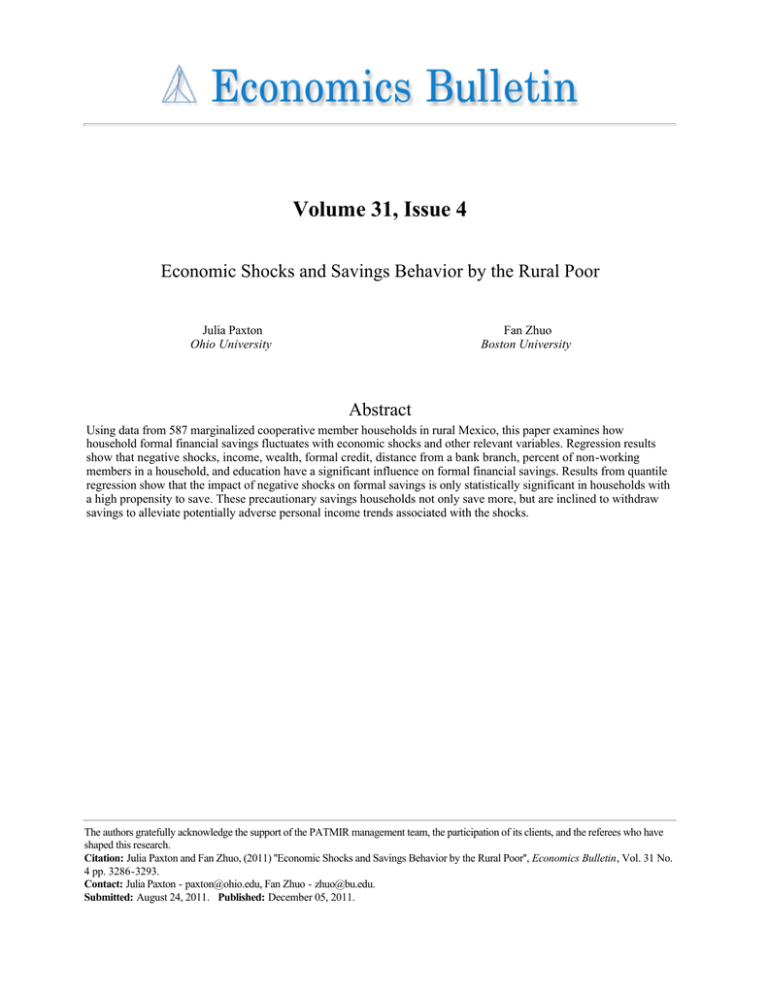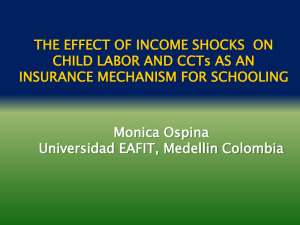Volume 31, Issue 4 Abstract
advertisement

Volume 31, Issue 4 Economic Shocks and Savings Behavior by the Rural Poor Julia Paxton Ohio University Fan Zhuo Boston University Abstract Using data from 587 marginalized cooperative member households in rural Mexico, this paper examines how household formal financial savings fluctuates with economic shocks and other relevant variables. Regression results show that negative shocks, income, wealth, formal credit, distance from a bank branch, percent of non-working members in a household, and education have a significant influence on formal financial savings. Results from quantile regression show that the impact of negative shocks on formal savings is only statistically significant in households with a high propensity to save. These precautionary savings households not only save more, but are inclined to withdraw savings to alleviate potentially adverse personal income trends associated with the shocks. The authors gratefully acknowledge the support of the PATMIR management team, the participation of its clients, and the referees who have shaped this research. Citation: Julia Paxton and Fan Zhuo, (2011) ''Economic Shocks and Savings Behavior by the Rural Poor'', Economics Bulletin, Vol. 31 No. 4 pp. 3286-3293. Contact: Julia Paxton - paxton@ohio.edu, Fan Zhuo - zhuo@bu.edu. Submitted: August 24, 2011. Published: December 05, 2011. Economics Bulletin, 2011, Vol. 31 No. 4 pp. 3286-3293 1. Introduction Understanding how poor, rural households cope with shocks is critical for development policy yet precautionary savings behavior among poor households in developing countries is not well understood. In the absence of formal financial institutions, the poor must make use of kinship networks, aid, and informal sources of savings to cope with negative shocks. As financial institutions become available to the rural poor, how formal savings can ease the sting of economic shocks is not well understood. According to Modigliani (1986), the poor with limited income and wealth save a smaller (or negative) portion of their income than higher income households, indicating a positive relationship between income and wealth, and formal financial savings. However, many recent studies based on developing country data point out that the low-income households, which experience difficulties and fluctuations, also need accumulated savings to smooth their income over economic shocks (Collins, et al., 2009; Rutherford, 2000). In this scenario, formal financial savings as a part of households’ liquid assets may have a negative relationship with income, meaning that low-income households need more liquid savings in order to cope with economic fluctuations since they are more vulnerable to income and consumption variability. Precautionary savings models predict that promoting savings among low-income households to facilitate long-term goals like homeownership or pension income may be less important than the benefits that can be achieved when savings can be used to smooth income and consumption during shocks (Skinner, 1988; Cagetti 2003). Paxson (1992) studied the savings behavior of Thai farm households and revealed that propensities to save due to economic shocks are quite high, indicating that income fluctuations do not have serious welfare consequences for farm households. Formal financial savings are used as buffer stocks to smooth consumption during and after economic shocks. Therefore, for households with economic fluctuations, formal financial savings are accumulated before shocks and used during and after shocks to offset income variability and to smooth consumption, indicating a negative relationship between formal financial savings and number of shocks. Lee and Sawada (2010) find that in rural Pakistan, the precautionary savings motive is more pronounced when access to credit markets are limited. This paper examines how the formal financial savings of low-income households in Mexico changes with the variation of different factors, such as income, use of banking, travel time, household composition, and economic shocks. It builds on the existing literature by disaggregating households savings by decile to analyze the effect of shocks on formal savings and focusing on rural, poor households in a developing country context. 2. Data In 2003, the Mexican Secretary of Agriculture, Livestock, Rural Development, Fisheries, and Food (SAGARPA) and the National Bank of Savings and Financial Services (BANSEFI) initiated a collaborative project named the Project of Technical Assistance for Rural Microfinance (PATMIR). Focusing on several Mexican states identified as having high levels of marginalization, this project targeted financial cooperatives as the vehicle for achieving greater outreach and sustainability in selected marginalized areas (Paxton, 2007). 3287 Economics Bulletin, 2011, Vol. 31 No. 4 pp. 3286-3293 This paper uses PATMIR data collected in 2004 – 2007 from 587 households. Table 1 lists the descriptive status of these households. These households are all financial cooperative members who have access to formal financial intermediaries. The average formal financial savings of these households is 5,941 pesos, while 111 households have no money in savings accounts. The formal savings is a stock variable measuring the total amount of active savings in any formal savings account at the time of the survey. Seventy two percent of households also had a formal loan from the cooperative, averaging 10,070 pesos at the time of the survey. In order to determine whether or not distance to the cooperative affects the amount of savings, a travel time variable was included that measured the number of minutes it takes to reach the cooperative. The average household had to travel 25 minutes to reach the nearest bank branch. Table 1: Characteristics of cooperative member households Dependent Variable FFS (2004 pesos) Independent Variable Income (2004 pesos) Wealth (2004 pesos) Formal Credit (2004 pesos) Travel Time (minute) % Non-Working HH members Shocks Age (years) Education (years) Min Max Mean 0 335000 5931 2 130 0 0 0 0 17 0 1126850 4430127 300000 360 100 5 95 21 67793 233080 10070 25 32.22 1 47 10 The income variable measures the total income received by the household over the course of the previous year including informal and formal income from both agricultural and non-agricultural sources. The wealth variable includes the value of all household assets ranging from financial savings (formal and informal), livestock, grain, equipment, appliances, tools, land, house, etc. The average household income is 67,863 pesos and the average household asset value is 239,671 pesos. The number of shocks in each household is listed in the data set to study the existence of the precautionary savings. The shocks variable gives the total number of shocks experienced by the household in the previous year and includes idiosyncratic shocks, such as illness, death, job loss, and systemic shocks, such as low agricultural prices, recession, and natural disaster. Financial instruments are used more to confront idiosyncratic shocks than for systemic shocks (Paxton and Young, 2011). One might expect that households use formal financial savings as a way to buffer the impact of shocks. The data set shows that the average formal financial savings is 7,198 pesos for households experiencing no economic shock in 2004, 5,607 pesos for households experiencing only one shock, and 3,565 pesos for households experiencing more than one shock, which implies that during and immediately after economic shocks, formal financial savings serve as buffer stocks to cope with financial difficulties. 3288 Economics Bulletin, 2011, Vol. 31 No. 4 pp. 3286-3293 Demographic information is also included in the dataset such as the ratio of dependents (nonworking members) to working members in the household, the age of the head of household, and the number of years of education of the household head. If the household head is under age of 30, the average amount of formal financial savings is 5,016 pesos. Meanwhile, if the age of the household head is between 31 and 60, the average formal financial savings increases to 6,174 pesos, and after age of 60, the average formal financial savings drops to 5,541 pesos. This phenomenon may indicate a hump-shaped formal saving pattern over household head ages, which follows the precautionary saving pattern studied by Gourinchas and Parker (2002). The dataset also shows that the relationship between household’s years of education and household formal financial saving is non-linear. With less than 6 years of education, household heads save about 4,487 pesos. If the household heads obtain 6 to 12 years of education, they save 3,953 pesos in financial institutions and if the household heads get more than 12 years of education, their average formal financial savings increases to 11,070 pesos, possibly indicating a U-shape pattern for household formal financial savings over education. 3. Empirical Model and Results An empirical model is estimated for households’ formal financial savings based on the savings function presented by Paxton and Young (2011). The equation takes the form: FFS=f[α0+α1(Y)+α2(W)+α3(CRD)+α4(TT)+α5(NWK)+α6(SHK)+α7(AGE)+α8(AGESQ)+α9(ED U)+α10(EDUSQ)+α11(SHK*W)] (1) The results of the CUSUMSQ and Rainbow tests led to an acceptance of the null hypothesis and the conclusion that the model is correctly specified. Empirical results are presented in Table 2. Table 2: Regression coefficients, standard errors and t-statistic Included observations: 587 Independent Variables Coefficient Std. Error t-Statistic Prob. α0 (Constant) α1 (Income) α2 (Wealth) α3 (Formal Credit) α4 (Travel Time) α5 (% Non-Working) α6 (Shocks) α7 (Age) α8 (Age Squared) α9 (Education) α10 (Education Squared) α11 (Wealth * Shocks) -5665.899 0.0317 0.0275 0.086 -38.649 5742.109 2074.542 324.765 -3.801 -980.552 48.339 -0.014 8458.257 0.009 0.004 0.032 20.379 3196.029 894.933 304.561 2.909 422.743 18.500 0.002 -0.670 3.732*** 6.306*** 2.669*** -1.897* 1.797* 2.318** 1.066 -1.307 -2.319** 2.613* -6.192* 0.5032 0.0002 0.0000 0.0078 0.0584 0.0729 0.0208 0.2867 0.1919 0.0207 0.0092 0.0000 *Significant at 10% level, ** Significant at 5% level, *** Significant at 1% level. 3289 Economics Bulletin, 2011, Vol. 31 No. 4 pp. 3286-3293 According to the regression results, the coefficients of income (Y) and wealth (W) are both positive and significant at the 1% level. This result indicates that households with considerably higher income and wealth choose formal financial savings as their financial instrument for accumulating assets, achieving safety and positive returns. The coefficients for age and age squared are not significant. The coefficient of formal credit variable (CRD) is also positive and significant at the 1% level, indicating that having access to formal credit may allow households to use formal savings for household spending and business expenditures at the same time. This finding follows the debt puzzle literature found among credit card holders in developed countries who also have liquid assets (Angeletos, et al., 2001). The introduction of formal financial saving and credit helps households smooth their spending, buffer the impact of shocks and provide them with more diversified financial portfolios. As expected, the distance to the nearest bank branch affects the amount of formal savings that a family accumulates. Since the average household has a 25 minute commute, the transaction costs associated with formal savings are considerable. As the distance to the cooperative increases, formal savings is affected. Technological advances using electronic and branchless banking offer promise in increasing savings in remote, rural areas. The coefficient of the percentage of non-working family members in a household (NWK) is positive and significant at the 10% level. Ex ante, this variable could be either positive or negative since households with many dependents might need to draw down savings. However, in this case, households with an increasing percentage of dependent family members put more savings in formal financial institutions for future spending related to education or medical expenses. The coefficient of education is negative while the square of education is positive. Both coefficients are significant at the 5% and 1% levels. The U-shape curve generated by these two variables indicates that the household heads with lower level of education may accumulate formal financial savings as buffer stocks because low level of education may lead to more unstable income. Meanwhile, the household heads, whom are at early stage of education (less than 10 years of education according to the regression result), may turn to formal financial savings to pay for education, which leads to lower level of formal financial savings. Finally, the positive relationship between education level and the return on education implies that the formal financial savings increases with the education level of the household heads after about 10 years of education. The coefficient of number of shocks (SHK) comprises two competing effects. On the one hand, vulnerable households with many shocks may need to build up precautionary savings. On the other hand, exposure to shocks may force households to draw down savings. For the purpose of this study, shocks are examined in two ways: as a single independent variable, and also as an interaction variable with wealth. The sign of the shocks variable is positive and significant at the 5% level indicating that households with many shocks tend to build up formal savings. However, the negative impact of shocks is found in the negative and statistically significant interaction term. This result may indicate that wealthier households liquidate their formal financial savings 3290 Economics Bulletin, 2011, Vol. 31 No. 4 pp. 3286-3293 as a coping mechanism to smooth consumption through adversity. In order to further explain the relationship between savings and shocks, quantile regression analysis is performed. In order to measure the impact of economic shocks by savings deciles, quantile regression was performed and the results are presented in Table 3 and Figure 1. Interestingly, the results indicate that after an economic shock, only the top three deciles have a statistically significant reduction in their formal savings. These groups might be considered precautionary savers since they have demonstrated ex post that they utilize savings in the face of economic shocks. If a household’s formal financial saving falls in the 70% decile, the household’s formal financial savings decreases by 436 peso after an economic shock. However, if households’ formal financial savings fall in 80% and 90% deciles, their formal financial savings decrease by 634 and 773 pesos respectively. Among the lower formal savings deciles, the use of formal savings was not the preferred mechanism for coping with the shock although each of these households had access to formal savings. Most of the households in the dataset had a statistically insignificant change in formal savings after a shock indicating that their formal savings were either inadequate to cope with the shock or that other informal coping mechanisms were preferred. Table 3: Quantile regression coefficients, standard errors and t-statistic for shock variable FFS decile Coefficient Std. Error t-Statistic Prob. Shock 0.100 -1.99E-13 83.19189 -2.39E-15 1.0000 Variable: 0.200 -28.33385 107.5618 -0.263419 0.7923 0.300 -72.58813 120.8314 -0.600739 0.5483 0.400 -105.0548 122.8537 -0.855121 0.3928 0.500 -152.8952 117.7290 -1.298704 0.1946 0.600 -101.8129 120.3202 -0.846183 0.3978 0.700 -374.6468** 172.5585 -2.171129 0.0303 0.800 -558.2491** 261.6727 -2.133387 0.0333 0.900 -876.6913** 416.8419 -2.103175 0.0359 *Significant at 10% level, ** Significant at 5% level, *** Significant at 1% level. 3291 Economics Bulletin, 2011, Vol. 31 No. 4 pp. 3286-3293 Figure 1: Quantile regression result for shock variable 4. Conclusions This paper used sample data from the 2004 PATMIR survey to study saving behavior and riskcoping strategies within the Mexican context. Regression results show that income, wealth, formal credit, distance to the nearest bank branch, percent of non-working members in a household, and education have a significant influence on formal financial savings among poor rural households. Regression analysis finds a positive relationship between formal savings and shocks, but once a wealth/shock interaction term is included, this relationship becomes negative. This finding implies that vulnerable households tend to build up precautionary savings and wealthier households which experience shocks tend to draw down savings after a shock. Quantile regression helps to shed light on these results by showing that the use of formal financial savings during economic shocks varies among households. The households with more formal savings withdrew more from this account to handle the economic shock whereas the volume of formal savings was unaffected by shocks among the majority of the savings deciles. This may indicate the presence of a critical threshold for precautionary savings. Until accounts grow to a certain level of savings, cooperative clients may not consider them as a coping mechanism for shocks or perhaps the smaller accounts were allocated for other uses. Given that all the households in the sample had access to formal savings, the fact that only the top three deciles had a statistically significant drop in formal savings after a shock raises important empirical questions for future research. Do these households have a different underlying savings function that incorporates precautionary savings or do low formal savings households have different informal risk coping mechanisms? Flushing out differences by savings decile can provide important answers to these questions and guide policy makers in providing appropriate financial services for the rural poor to smooth their income and consumption over unstable employment and volatile earnings. 3292 Economics Bulletin, 2011, Vol. 31 No. 4 pp. 3286-3293 References Angeletos, G., D. Laibson, J. Tobacman, S. Weinberg, and A. Repetto (2001) "The Hyberbolic Consumption Model: Calibration, Simulation, and Empirical Evaluation" Journal of Economic Perspectives 15:3, 47-68. Banerjee, A.V. and E. Duflo (2007) “The Economic Lives of the Poor” Journal of Economic Perspectives 21:1, 141-168. Cagetti, M. (2003) “Wealth Accumulation Over the Life Cycle and Precautionary Savings” Journal of Business and Economic Statistics 21:3, 339–353. Collins, D., J. Morduch, S. Rutherford, and O. Ruthven (2009) Portfolios of the Poor: How the World's Poor Live on $2 a Day, Princeton University Press: Princeton, NJ. Gourinchas, P.O. and J.A. Parker (2002) “Consumption over the Life Cycle,” Econometrica, 70:1, 47-89. Lee, J. and Y. Sawada (2010) "Precautionary saving under liquidity constraints: Evidence from rural Pakistan," Journal of Development Economics, 91:1, 77-86. Modigliani, F. (1986) “Life Cycle, Individual Thrift, and the Wealth of Nations” The American Economic Review, 76:3, 297-313. Paxson, C. (1992) “Using Weather Variability to Estimate the Response of Savings to Transitory Income In Thailand,” The American Economic Review, 82:1, 15-33. Paxton, J. (2007) “Contrasting Methodologies for Expanding Microfinance Outreach to the Rural Poor: Trade-Offs and Lessons Learned from Mexico’s PATMIR Project.” Savings and Development, 31:3, 283-306. Paxton, J. and L. Young (2011) “Liquidity Profiles of Poor Mexican Households” World Development, 39:4, 209-231. Rutherford, S. (2000) The Poor and their Money, Oxford University Press: New York. Skinner, J. (1988)“Risky Income, Life Cycle Consumption, and Precautionary Savings”, Journal of Monetary Economics, 22, 237-255. 3293






